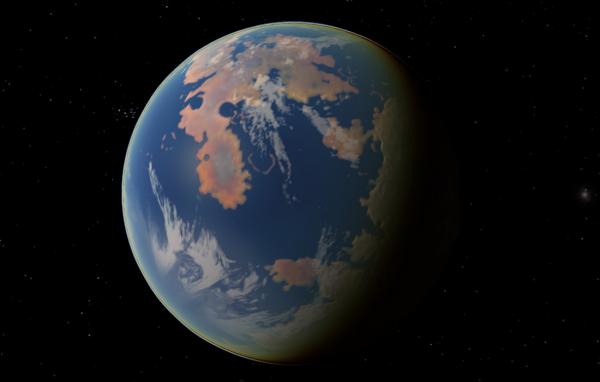BY LETTER
Neo-Helix
Galactography > Regions of Space > Inner Sphere
Galactography > Systems and Worlds > Systems & Worlds M - N
Galactography > Systems and Worlds > Systems & Worlds M - N
World with an early neogenic ecosystem | |
 Image from Steve Bowers | |
| Genext, 36 Ophiuchi C, with the distant twin stars A + B (Guniibuu and Clyde) in the distance. | |
| System | Stars: 36 Ophiuchi A, B, C Distance from Sol: 19.47 ly (J2000 epoch) Constellation Ophiuchus Arity Triple. A+B form a close binary, and C is more distant. A+B are very similar is mass and luminosity. Neo-Helix orbits the C Star, Genext. 36 Ophiuchi A, Guniibuu, HR 6402 Type: K1 Ve orange dwarf Luminosity: 0.33 x Sol Mass 0.85 x Sol 36 Ophiuchi B, Clyde, HR 6401 Type K1-5 Ve orange dwarf Luminosity: 0.36 x Sol Mass 0.85 x Sol Semimajor axis of B's orbit around A: 88 AU (in a highly eccentric orbit). Closest approach of B to A: 6.8 AU The A+B stars approach very closely at periastron, and this has prevented the formation and persistence of any significant orbiting objects around these two stars. 36 Ophiuchi C, Genext, HIP 84478 Type K5V orange dwarf Luminosity: 0.2 x Sol Mass 0.71 x Sol Semimajor axis of C's orbit around A+B: 4500 AU Only the C star has any significant planets. Colonised: 1191 AT |
|---|
 Image from Steve Bowers | |
| Neo-helix during the Integration, when the neogen biosphere was mostly concentrated near the seashore. In later eras the project managers took this world in several quite different evolutionary directions, with a diverse range of results. | |
| Planets | Deoxy Semi-major axis 0.0361 AU Period 0.00814 standard years Diameter 2797km Mass 0.009 x Earth Gravity 0.19 gees ------------- Betterine Semi-major axis 0.12 AU Period 0.0493 standard years Diameter 3864 KM Mass0.01 x Earth Gravity0.118 gees --------- Neo-Helix Semi-major axis 0.461 AU Period 0.372 standard years Diameter 7128 km Mass 0.241 x Earth Gravity 0.774 gees |
|---|
During the Version War Neo-Helix became largely isolated due to the reduction in non-military travel, and the evolution of the neogen lifeforms on this world began to take some unusual directions. The continental regions and parts of the seas were paved over with an interdependent web of lifeforms, each working with the others to increase the potential for organic growth in each environment.
Later, after the Age of Crisis, the entire nature of this planet's biosphere was changed; the management of the planet was assumed by the Zoeific Biopolity, who re-engineered the planet's environment to increase the stress level, producing an artificial post-apocalyptic scenario which produced many interesting (and sometimes disturbing) results.
In the Current Era the various biomes on this world are somewhat less extreme, but they are still in a state of constant change in response to environmental changes, some of which are allowed to occur naturally and others which are deliberately engineered.
 Image from Anders Sandberg | |
| One of the most common artificial organisms on this world is the Thingie, a colonial, photosynthetic auto-heterotroph found on the seashore, which slowly crawls over the landscape and devours other, more sessile organisms | |
Related Articles
- Ecopoiesis - Text by M. Alan Kazlev
The science and art of designing, shaping, sculpting, or modifying ecosystems.
Appears in Topics
Development Notes
Text by Todd Drashner
additional material by The Astronomer, Steve Bowers
Initially published on 07 January 2002.
additional material by The Astronomer, Steve Bowers
Initially published on 07 January 2002.






